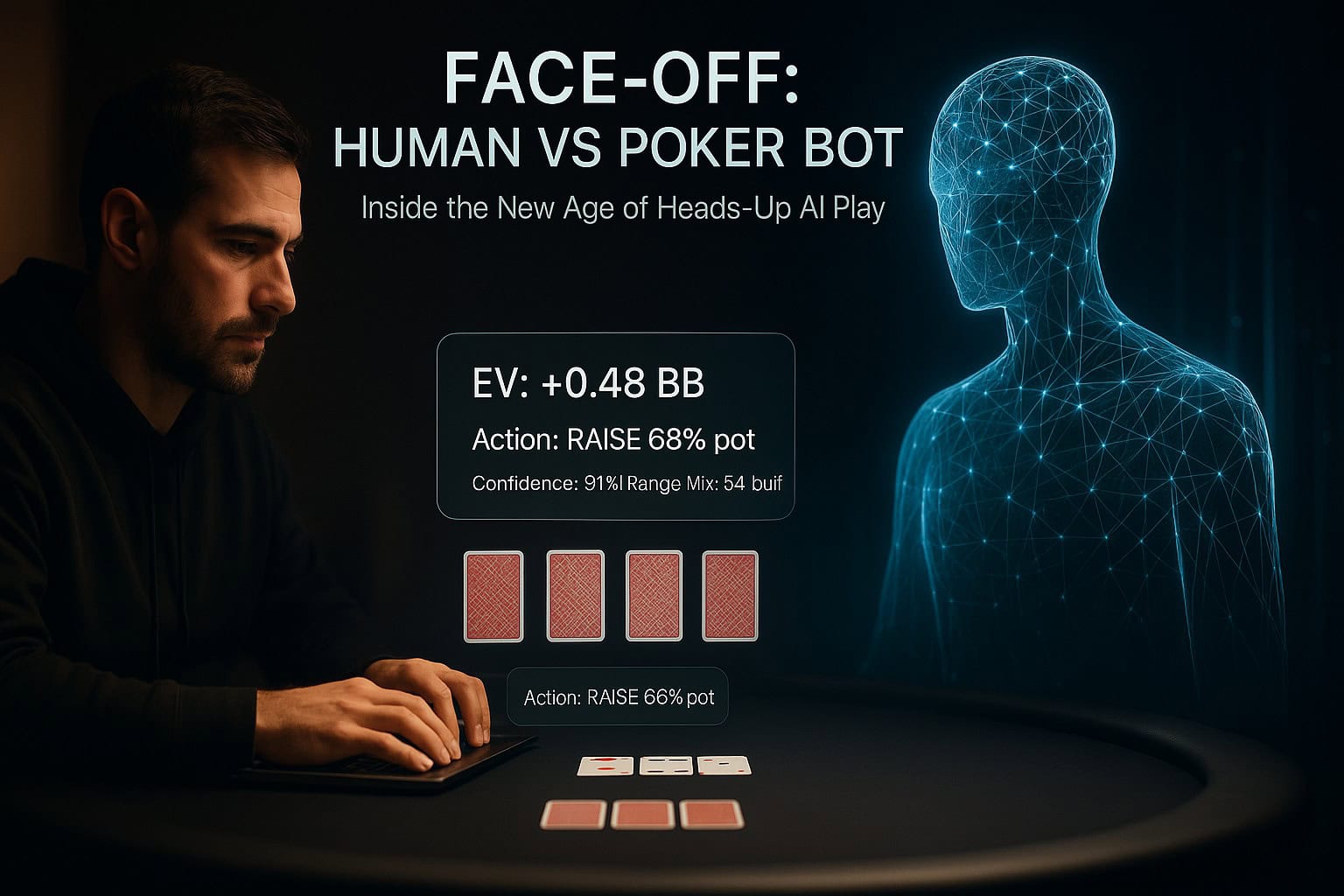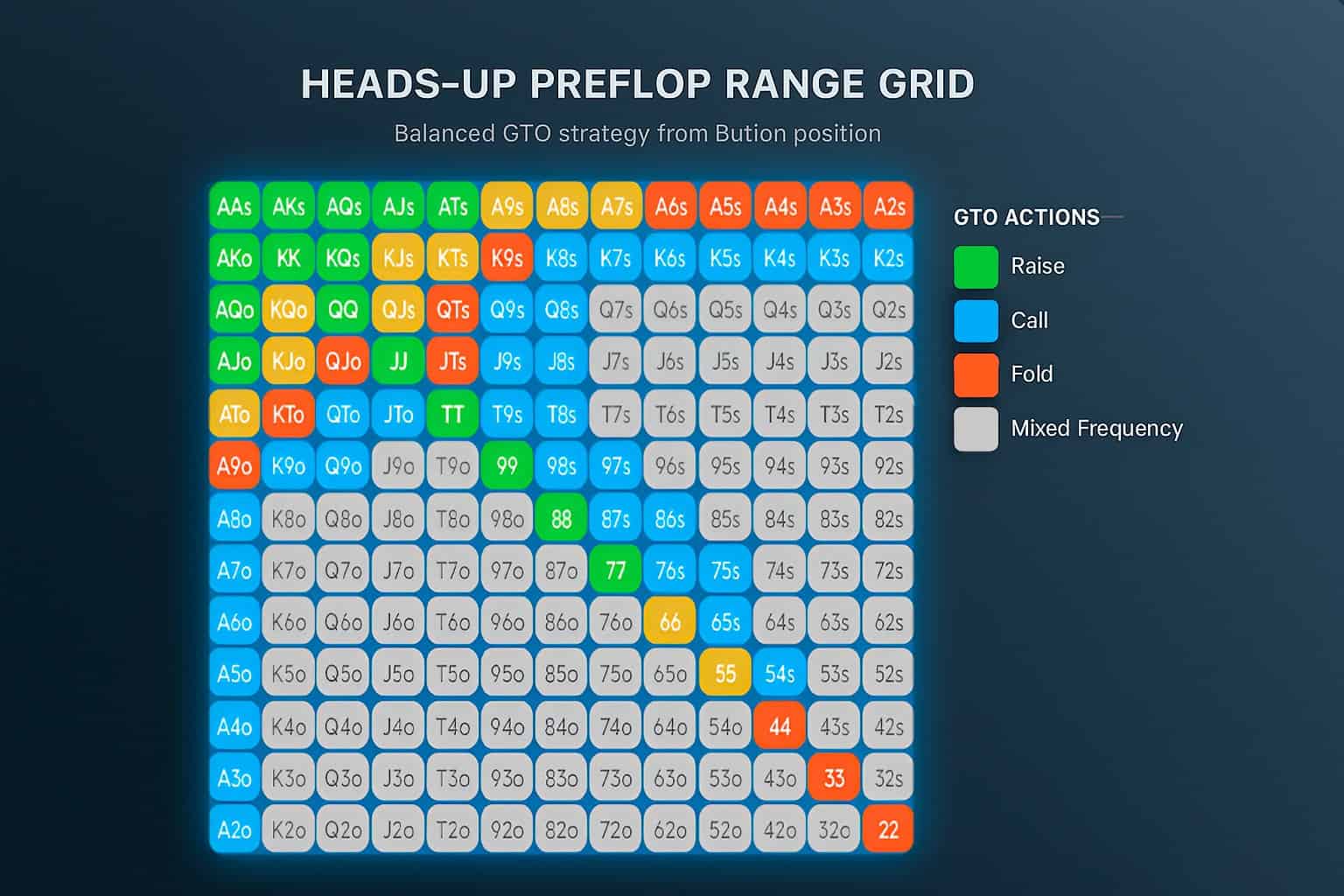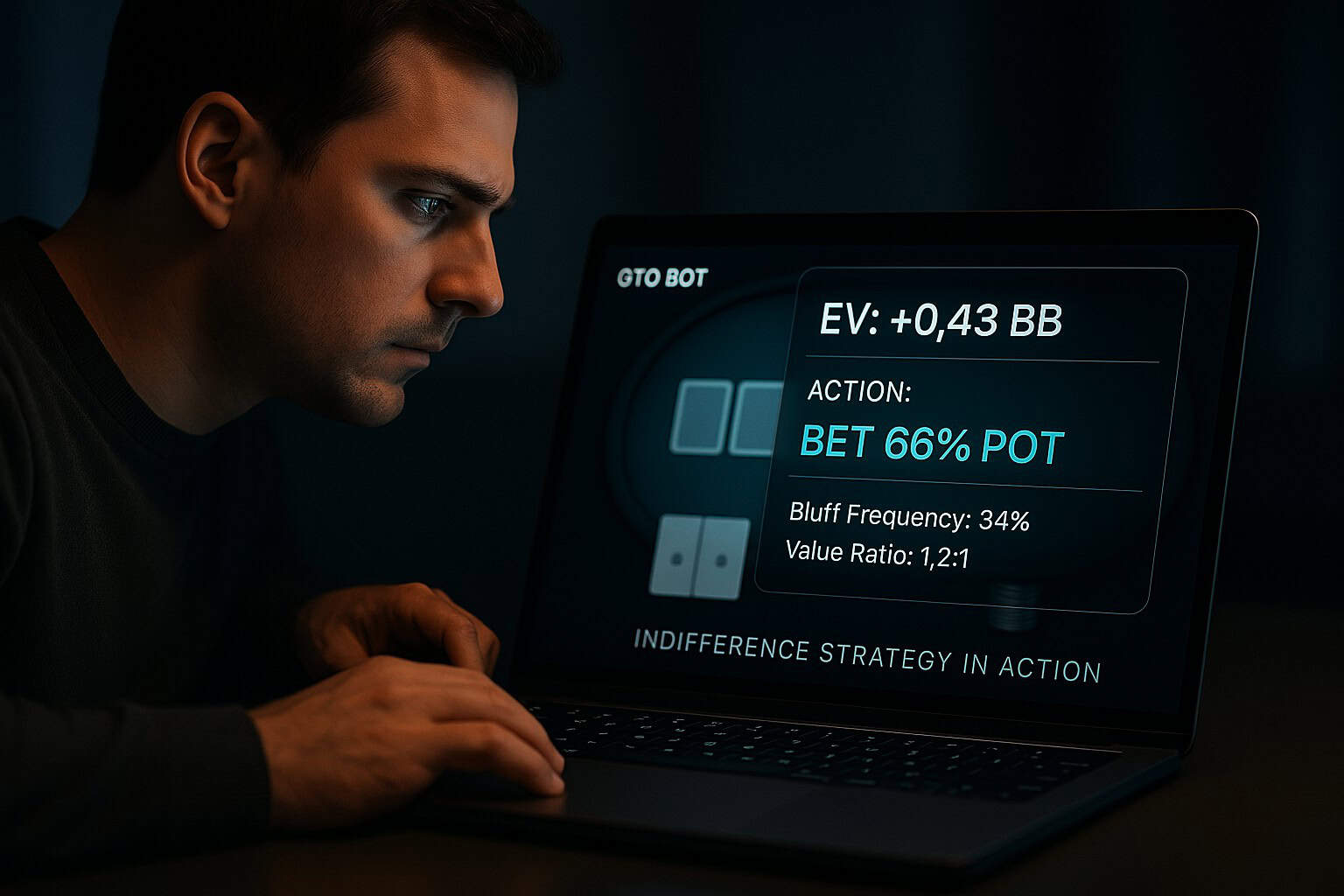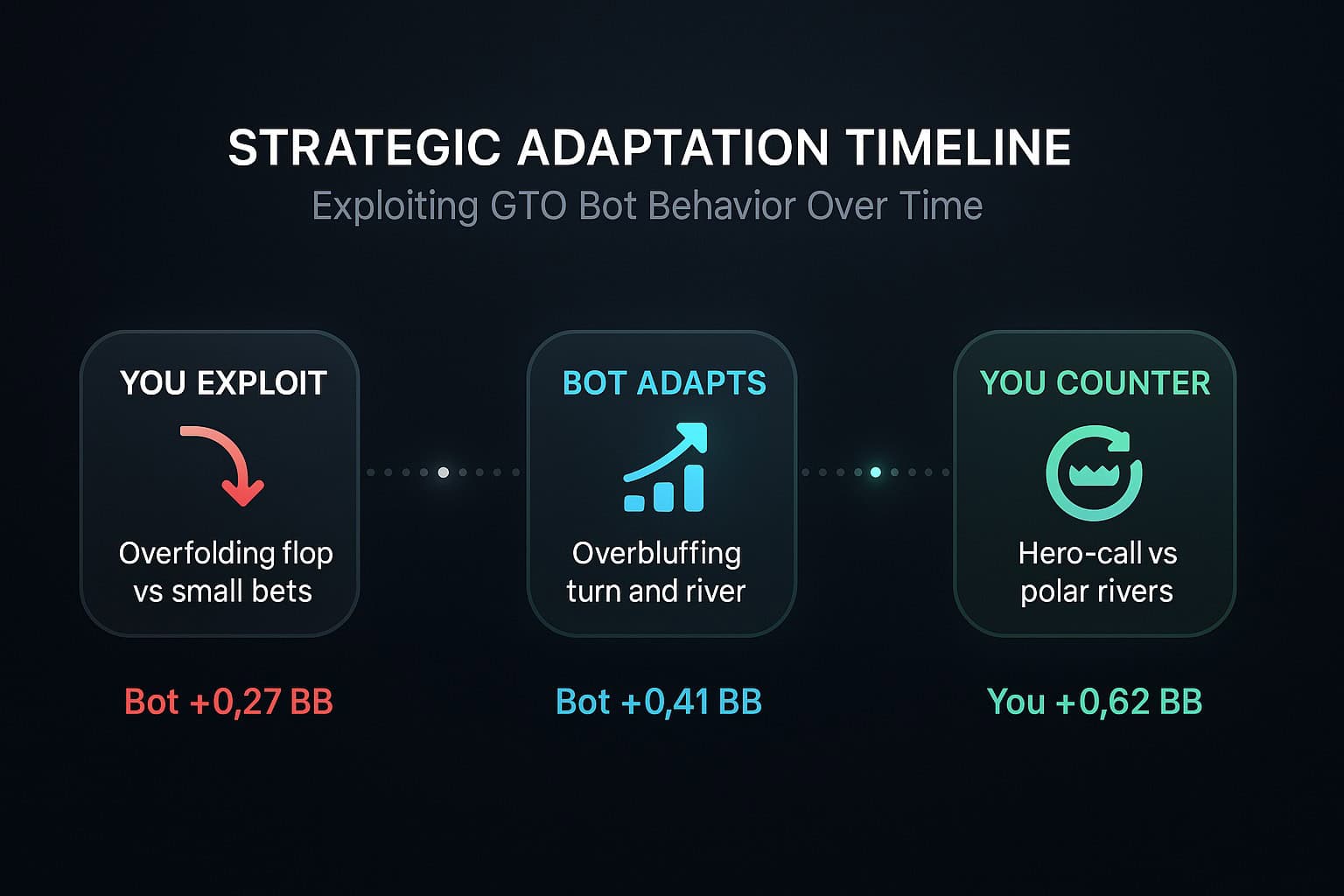
Heads-Up Play: AI Poker Bot Tactics
Heads-up poker is the purest form of the game. No distractions, no multiway chaos – just you and your opponent in a battle of minds (or… algorithms?).
In recent years, AI poker bots have changed the way heads-up is played – on training apps, real tables, and even in high-stakes online arenas. These bots don’t tilt, don’t forget, and never make the same mistake twice.
So how exactly do bots play heads-up – and what can you do about it?
Let’s break it down.
Why Heads-Up Is the Ultimate Testing Ground
Heads-up poker strips the game to its core: one opponent, infinite iterations, and maximum pressure.
Every hand counts. Every frequency matters. And every leak gets punished fast.
That’s why heads-up poker became the go-to arena for training advanced bots like Pluribus, DeepStack, and modern poker AI engines. The smaller game tree and constant decision density make it ideal for testing:
- GTO balance
- Bluff frequencies
- Range adaptation
- Pressure application
It’s also why most human solvers train in heads-up mode before jumping into full-ring chaos.
How Bots Play Heads-Up Differently Than Humans

Bots don’t play like us.
They don’t care about metagame or ego. Their only goal: maximize EV. And in heads-up, they do it brutally well.
Here’s how:
- Perfect Range Construction
Bots know exactly how to build and protect ranges across all street textures:
- Preflop open from button with mixed frequencies: 80%–100% hands
- Wide 3-bet defense range in BB, using blockers and low equity hands to balance
- Balanced check, bet-small, and overbet strategies based on texture and equity distribution
They never forget the bottom of their range – and they never value-bet too thin or miss a bluff spot.
- Indifference at the Margins
When facing marginal decisions, bots play to make you indifferent:
- Call here, fold there – not because it feels right, but because it’s mathematically equal
- They mix hands at low EV thresholds to avoid becoming readable
Humans often overvalue “feeling” in these spots. Bots just execute mixed-strategy math.
- Hyper-Adaptive Exploits
Some bots – especially those trained for exploitative play – go beyond GTO.
They track:
- Your fold-to-C-bet % by texture
- Your river aggression
- Bet timing and sizing leaks
Then they use this data to 3-bet light, float more, or jam rivers when you fold too much.
You won’t even know you’ve been outplayed – just that you lost a lot of small pots, then one huge one.

Pluribus: The Blueprint
Facebook’s Pluribus bot was one of the first AI systems to dominate human pros in 6-max – but it started with heads-up.
It used:
- Monte Carlo CFR (Counterfactual Regret Minimization)
- Real-time decision updates
- Shallow lookahead trees (not full-game solve)
- No human training data – just self-play
And it crushed.
Pluribus showed that bots could build near-GTO strategies without solving the entire game. That’s crucial for real-time application.
Many of today’s best poker bots in apps use similar structures – smaller trees, heavy abstraction, and fast exploitation layers.
Can Humans Still Compete?
Yes – but not by “outplaying” bots.
To win, you need to:
- Understand what bots are good at
- Know where they overfit
- Use tactics they’re weak against
Here’s how.
How to Fight Back: Human vs AI in Heads-Up

- Exploit Their GTO Bias
Most bots play GTO by default. That means:
- They don’t deviate unless you do first
- They assume you’re optimal – so they don’t exploit leaks immediately
That gives you a window.
Example:
- Overfold to small flop bets for 10–15 hands
- Bot registers this as your baseline
- Suddenly it starts overbluffing turn and river
Now? You snap-call wider and catch them.
Timing is everything.
- Change Tempo and Sizing
Bots track rhythm and size buckets. Disrupt it:
- Use non-standard sizings (e.g. 2.1x preflop opens, 55% flop bets)
- Delay C-bet spots on dry boards, then raise turn
This doesn’t confuse them – but it takes them out of pre-learned clusters.
It’s the poker equivalent of jazz: make them re-calculate constantly.
- Lean into Feel + Context
Bots are better at logic. You’re better at context.
- Exploit meta-game: if they 3-bet a ton, go limp-trap
- Use known timing tells from apps that use “bot-like” behavior
- Adjust based on match flow – not just stats
You’re still a human. That’s a strength.
Heads-Up Bots in the Wild: Are They Cheating?
When bots show up on real tables, the ethics change.
If a bot plays live heads-up online and:
- Reads ranges
- Uses solver outputs in real-time
- Plays perfect frequencies
…it’s likely breaking ToS. That qualifies as RTA (Real-Time Assistance), and many platforms ban this tech.
That said, bots are:
- Used legally in training
- Appearing on apps like Lucid, GTOBase, PokerAlfie
- Built into high-end study tools
So: poker bots aren’t always cheating – but yes, if someone uses one during real heads-up play, it’s a poker cheat.
Are You Playing Against a Bot?

Signs of a heads-up poker online bot:
- No chat
- Never tanks, perfect timing
- Always mixed frequencies (0.33, 0.66, pot)
- Never shows strange hands out of position
If it feels like a machine, it probably is. Use behavior tools or report to support.
Better yet: study that session. You just got a GTO sparring match for free.
Final Thoughts: The Battle for 1v1
Heads-up poker is now a frontier between:
- AI perfection
- Human creativity
- Adaptive exploit vs mechanical balance
You don’t need to beat bots to win in this game. You need to understand them, train like them, and sometimes – exploit them.
So next time you’re in a heads-up spot, ask:
“Is this just a hand…
or a test of how human I still am?”
Because the bots are watching. And they never blink.
